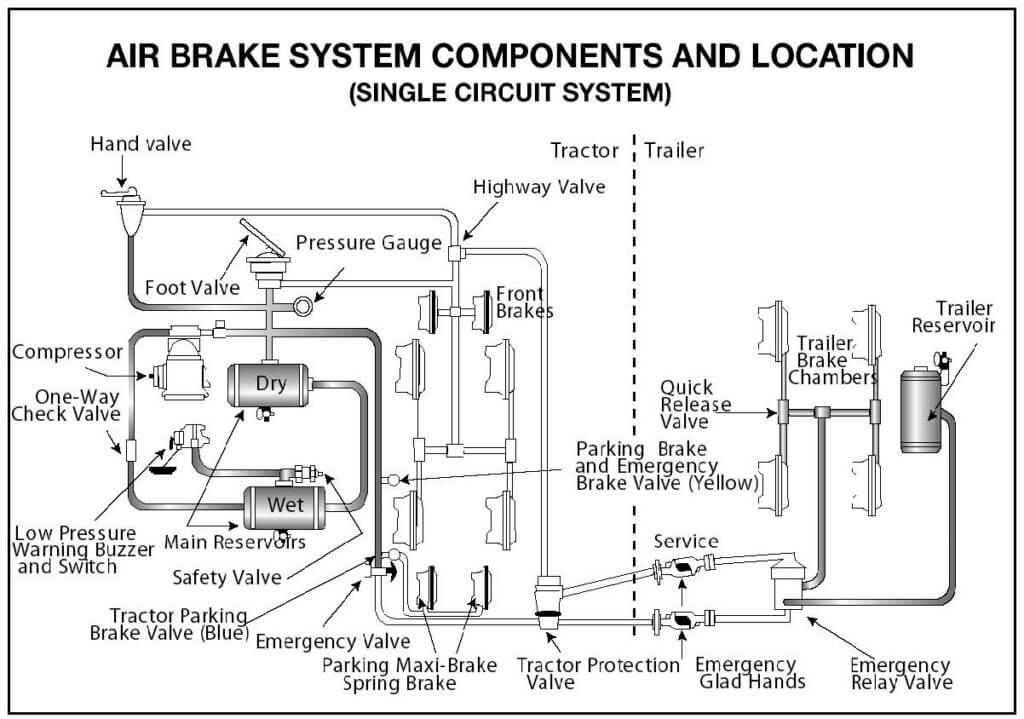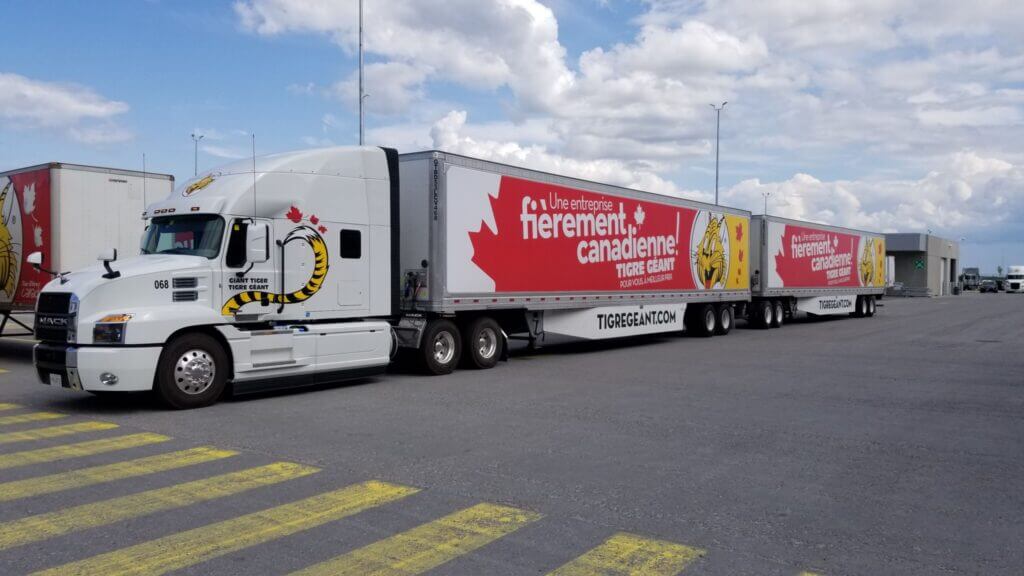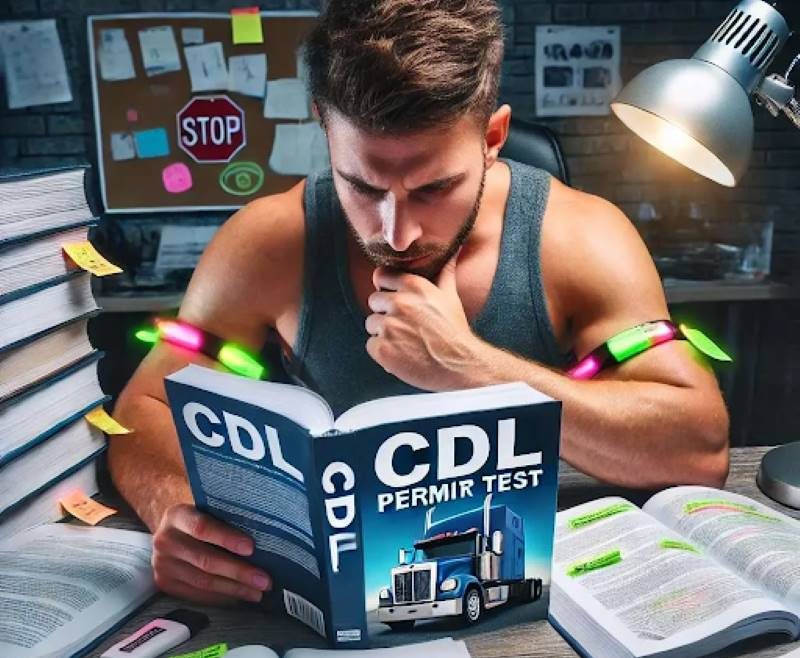Obtaining a CDL permit (CLP) is a ticket to get into the world of commercial driving, but do you know What are the 3 tests for CDL permit? The 3 major tests you can encounter on the CDL permit test are general knowledge, air brakes, and combination vehicles. Many aspiring drivers feel overwhelmed with these tests, but don’t worry! The process is simpler than you think once you grasp what exactly waiting for you in these 3 tests. Therefore, this guide dives deep into each test, explaining what it is, how it is structured,d and what to expect. Some helpful advice to prepare for CDL permit tests is also covered. Keep reading to lay a foundation for acing a CDL permit now!
What are the 3 tests for CDL permit?
The 3 tests you can be required to take when pursuing a CDL permit (CLP) are:
- General knowledge test: Required for all CDL applicants.
- Air brakes test: Applied if you intend to drive vehicles with an air brake system.
- Combination vehicles test: Required for Class A CDL applicants.
Let’s dive into each test to discover what is covered:
General knowledge test

The general knowledge test is designed to be a comprehensive assessment for all applicants for a CDL permit. This ensures you have a solid foundation in commercial driving, safety protocols, and vehicle operation. You must take 50 multiple-choice questions and achieve at least 80% to pass. It encompasses a broad range of areas that are essential in understanding and operating commercial vehicles.
Subjects covered on the CDL general knowledge test are as follows:
- Basic vehicle operation:
- How commercial vehicles differ from conventional vehicles in terms of size, weight, and mechanical complexity.
- The primary systems operating within the vehicle, include the engine, transmission, braking systems, and the management of fuels.
- Pre-trip inspections:
- Describe the sequential process of inspecting a vehicle to determine whether it is roadworthy.
- Highlight tire, brake, light, and fluid checks, and secure the cargo.
- Basic vehicle control:
- Master the techniques in handling commercial vehicles by steering acceleration, and braking.
- Learn wide turns, sharp curves, safe backing
- Space management:
- Learn to keep a distance between your vehicle and other traffic around you.
- Learn to manage/cope with limited space around parking areas/urban flow.
- Weather and road conditions:
- Learn how weather and the road affect the operation of vehicles.
- The tips cover adjustment for rain, ice, or fog and realizing when driving is unsafe.
- Emergency response:
- Learn what to do in an emergency such as brake failure, engine overheating, or a collision.
Take CDL general knowledge practice tests
Air brakes test (if applicable)

The air brake test is a mandatory requirement for all CDL applicants whose vehicles are endowed with air brake systems. If you do not pass this test, you will have a restriction on your CDL that disallows you from driving such vehicles. The test has 25 multiple-choice questions and requires an 80% passing score. This test will assess your understanding of the components, operation, and safety procedures of air brake systems.
Topics covered in the air brake test include:
- Parts of an air brake system: Check your understanding of what makes an air brake system run safely and effectively. Some of the important components are as follows:
- Air compressor: Pumps air into the system to provide braking pressure.
- Air compressor governor: Regulates the compressor when to come on and when to turn off to maintain the proper air pressure.
- Air storage tanks: Store compressed air until needed for braking.
- Alcohol evaporator: Prevents moisture in the air lines from freezing in cold conditions.
- Air tank drains: Allow the driver to drain off moisture and oil accumulating in the air tanks to prevent system damage.
- Safety valve: Prevent the over-pressurizing of the system through the release of excessive amounts of air.
- The brake pedal: Trigger pressurized air into the brake chambers.
- Foundation brakes: The S-cam brakes or disc brakes that apply pressure to effect a halt.
- Application pressure gauge: Indicates the amount of air pressure being applied when the brakes are applied.
- Low air pressure warning: Warns drivers when air pressure falls to a dangerously low level, usually below 60 psi.
- Stop light switch: The brake lights light up to let other drivers know the brakes are on.
- Front brake limiting valve: Reduce air pressure to the front brakes depending on operating conditions.
- Parking brake controls: Engages or releases the spring brakes when parked.
- Anti-lock braking systems: Prevent wheel lock-up during heavy braking, improving vehicle control.
- Dual air-brake systems:
- Know that dual air-brake systems provide a backup in case one system fails.
- Identify the different roles of both the primary and secondary systems and describe how to check their pressure using a pressure gauge.
- Inspecting air brake systems:
- Inspecting air brake systems step by step during a pre-trip inspection.
- Procedure to check air tank drains, test the air pressure build-up rate, check for leaks, and check the operation of the low air pressure warning system.
- Using air brakes:
- Norman stops: How brakes should be applied to effect a stop without skidding.
- Anti-lock braking: Explain how ABS prevents wheel lock-up and maintains steering control during heavy braking.
- Emergency stops: How to safely stop in critical situations
- Stopping distance: How speed, weight of vehicle, and brake lag affect stopping distance.
- Proper braking techniques: How to use controlled braking and stab braking to maintain control in a number of situations.
- Brake fading or failure: Causes of brake fading and how to act if brakes fail.
- Low air pressure: Be able to recognize hazards when operating at air pressure too low and take the right action upon meeting such conditions.
- Parking brakes: Explain when and how parking brakes should be applied to secure a vehicle while stopped.
Take CDL air brakes practice tests
Combination vehicles test (if applicable)

The combination vehicles test is crucial for the issuance of a Class A CDL, ensuring you understand the complexities of operating combination vehicles and how to skillfully handle and master them. This will typically include 20 multiple-choice questions with a passing score of 80%.
This test covers critical topics on combination vehicles, specifically:
- Driving combination vehicles safely: Procedures to operate a combination vehicles under specific challenges, including:
- Rollover risks: Learn how to minimize the risk of rollovers by managing your speed in curves and taking care of cargo distribution.
- Steer gently: Understand why sudden steering can cause a combination vehicle to become unstable.
- Brake early: Learn why a combination vehicle takes longer and longer to stop safely.
- Railroad-highway crossings: Practices for crossing railroad tracks with long vehicles.
- Prevent trailer skids: How to recognize and correct skids before they become jackknifing.
- Turn wide: Know how to make wide turns to stay away from catching curbs or other obstacles with trailer wheels.
- backing with a trailer: Back with a trailer safely, understand pivot points and how to use your mirrors effectively.
- Combination vehicle air brakes: Complexibities of air brake systems on combination vehicles:
- Trailer hand valve: How and when to use the valve to test the trailer brakes.
- Tractor protection valve: Know how it works to prevent air loss from a tractor in case the air supply of the trailer fails.
- Trailer air supply control: Explain how to use this control to supply air to the trailer system.
- Trailer airlines: Explain service emergency and supply air lines and their functions in brake operation.
- Hose couples: Explain what these couplers are and how they connect air hoses between tractor and trailer.
- Trailer air tanks: The roles that these tanks play in maintaining air pressure.
- Shut-off valves: How to work the valves to shut off the air systems in emergencies or when going for inspections.
- Trailer service, parking, and emergency brakes: Operation and functions of the braking system on the combination vehicle.
- Coupling and uncoupling: Procedure to coupling and uncoupling a combination vehicle safely, covering:
- Coupling tractor-semitrailers: Describe a proper procedure for coupling a tractor and a semitrailer.
- Uncoupling the tractor-semitrailers: Describe the correct procedure for uncoupling the tractor-semitrailer to avoid damage or accident.
- Uncounping a pintle hook: Includes details for trailers that are connected by a pintle hook.
- Coupling a drawbar and gooseneck hitch: The procedures for attaching these types of specialty trailers are described.
- Inspecting a combination vehicle: Ascertain whether combination vehicles are safe to take onto the road. This section focuses on:
- Combination vehicle brake check: Be able to describe the testing of brakes both tractor and trailer to determine whether they work.
- Additional things to check: Trailer connections, airlines, and locking.
Take CDL combination vehicles practice tests
Tips to study for the CDL permit test

Earning a CDL permit is a significant milestone in your career as a professional driver. Follow the strategies below to turn your presentation into success on the test day:
Kickstart with CDL manual
The CDL manual lays the core of your preparation. It is full of information ranging from road rules to in-depth system explanations. Here is how you can make use of the manual:
- Break it into smaller sections and tackle with one at a time.
- Highlight important items and review them frequently.
- Make summaries in your own words to reinforce your understanding.
Set study habits
Good studying is not cramming but being consistent and focused:
- Set small goals: Decide how many practice questions or how many sections of the manual you will study each day.
- Take regular breaks: Your brain absorbs information more when you study in shorter intervals.
- Minimize distractions: Find a quiet, comfortable place to study and reduce unnecessary interruptions.
Adjust your learning style
Anyone learns in different ways. Find out what works best for you:
- Visual learners: Utilize flashcards, charts, and videos.
- Auditory learners: Read the material aloud or listen to recorded lessons.
- Kinesthetic learners: Practice hands-on activities such as going over a vehicle or demonstrating coupling procedures.
Use practice tests
Theoretical knowledge is important, but practice is the path to perfection. By taking CDL practice tests, you will be able to:
- Familiarize yourself with the test format and question types.
- Assess your current level and identify where need improvement.
- Sharpen your knowledge and confidence over practice tests.
Ready to test your skills? Practice tests by CDL Prep is one of the best reliable resources for helping you level up your test preparation like never before.
FAQs
1. Do I have to take all three tests for a CDL permit?
No, the test you have to take varies depending on what type of license and vehicle you are pursuing. All CDL applicants must take the general knowledge test. Any person desiring to operate any CMV equipped with air brakes must take the air brakes test. To get a Class A license, you must take the combination vehicles test.
2. How many questions can you miss on the CDL permit test?
To pass a CDL permit test, you must pass each of three tests with a score of at least 80%, meaning:
- General knowledge test: You are allowed to miss up to 10 questions.
- Air brakes test: You are allowed to miss up to 5 questions.
- Combination vehicles test: You are allowed to miss up to 4 questions.
Final thoughts
Understanding what are the 3 tests for CDL permit is crucial to effectively preparing for your trucking journey. Each test has its own purpose and covers different areas, ensuring you are qualified to obtain a CDL permit. Review carefully the topics involved in each test, and apply our suggested study strategies, from utilizing study materials, and practice tests, tailoring studying styles, and targeting areas specific to your CDL type. With proper resources and dedication, passing CDL permit tests is much more achievable. Study today and step closer to your CDL permit tomorrow! We are always here is assist your success!



